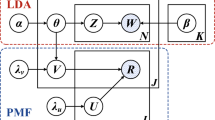Abstract
Socialized recommender system recommends reliable healthcare services for users. Ratings are predicted on the healthcare services by merging recommendations given by users who has social relations with the active users. However, existing works did not consider the influence of distrust between users. They recommend items only based on the trust relations between users. We therefore propose a novel deep learning-based socialized healthcare service recommender model, which recommends healthcare services with recommendations given by recommenders with both trust relations and distrust relations with the active users. The influences of recommenders, considering both the node information and the structure information, are merged via the deep learning model. Experimental results show that the proposed model outperforms the existing works on prediction accuracy and prediction coverage simultaneously, even for cold start users or users with very sparse trust relations. It is also computational less expensive.









Similar content being viewed by others
References
Gubbi J, Buyya R, Marusic S et al (2013) Internet of Things (IoT): a vision, architectural elements, and future directions. Future Gener Comput Syst 29(7):1645–1660
Zhang S, Yao L, Sun A (2017) Deep learning based recommender system: a survey and new perspectives. arXiv:1707.07435
Qi L, Xu X, Zhang X, et al (2016) Structural balance theory-based E-commerce recommendation over big rating data. IEEE Trans Big Data PP(99):1. https://doi.org/10.1109/TBDATA.2016.2602849
Tang J, Aggarwal C, Liu H (2016) Node classification in signed social networks. In: Proceedings of the 2016 SIAM international conference on data mining. Society for industrial and applied mathematics, pp 54–62
Koren Y, Bell R (2015) Advances in collaborative filtering. In: Ricci F, Rokach L, Shapira B, Kantor P (eds) Recommender systems handbook. Springer, New York, pp 77–118
Yuan W, Guan D, Lee YK et al (2010) Improved trust-aware recommender system using small-worldness of trust networks. Knowl Based Syst 23(3):232–238
Yuan W, Li C, Han G et al (2017) Negative sign prediction for signed social networks. Future Gener Comput Syst. https://doi.org/10.1016/j.future.2017.08.037
Zhang J, Lin Y, Lin M et al (2016) An effective collaborative filtering algorithm based on user preference clustering. Appl Intell 45(2):230–240
Moradi P, Ahmadian S (2015) A reliability-based recommendation method to improve trust-aware recommender systems. Expert Syst Appl 42(21):7386–7398
Yuan W, He K, Guan D et al (2017) Edge-dual graph preserving sign prediction for signed social networks. IEEE Access 5:19383–19392
http://www.epinions.com/. Accessed 30 Mar 2017
http://www.trustlet.org/epinions.html. Accessed 30 Mar 2017
Deng S, Huang L, Xu G (2014) Social network-based service recommendation with trust enhancement. Expert Syst Appl 41(18):8075–8084
Han G, Yang X, Liu L, et al (2017) A joint energy replenishment and data collection algorithm in wireless rechargeable sensor networks. IEEE Internet Things J
Han G, Zhou L, Wang H et al (2017) A source location protection protocol based on dynamic routing in WSNs for the Social Internet of Things. Future Gener Comput Syst. https://doi.org/10.1016/j.future.2017.08.044
Han G, Yang X, Liu L, et al (2017) A disaster management-oriented path planning for mobile anchor node-based localization in wireless sensor networks. In: IEEE Trans Emerg Top Comput
Zhang H, Chow TWS, Wu QMJ (2016) Organizing books and authors by multilayer SOM. IEEE Trans Neural Netw Learn Syst 27(12):2537–2550
Zhang H, Ji Y, Li J, Ye Y (2016) A triple wing harmonium model for movie recommendation. IEEE Trans Ind Inf 12(1):231–239
Acknowledgements
This research was supported by “the Fundamental Research Funds for the Central Universities” No. 3082016NS2016090.
Author information
Authors and Affiliations
Corresponding author
Ethics declarations
Conflict of interest
The authors declared that they have no conflicts of interest to this work.
Rights and permissions
About this article
Cite this article
Yuan, W., Li, C., Guan, D. et al. Socialized healthcare service recommendation using deep learning. Neural Comput & Applic 30, 2071–2082 (2018). https://doi.org/10.1007/s00521-018-3394-4
Received:
Accepted:
Published:
Issue Date:
DOI: https://doi.org/10.1007/s00521-018-3394-4




